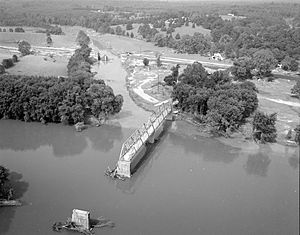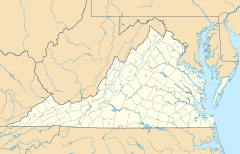Howardsville, Albemarle County, Virginia facts for kids
Quick facts for kids
Howardsville
|
|
|---|---|
| Country | United States |
| State | Virginia |
| County | Albemarle |
| Time zone | UTC−5 (Eastern (EST)) |
| • Summer (DST) | UTC−4 (EDT) |
| GNIS feature ID | 1495724 |
Howardsville is a small community in Albemarle County, Virginia. It's called an unincorporated community because it doesn't have its own local government like a city or town.
Howardsville got its name from Allen Howard, one of its main founders. He settled on the north side of the James River where the Rockfish River joins it. In the 1730s and 1740s, families like the Andersons and Jordans also settled here. They moved from other parts of the James River to grow crops like tobacco. This area was also known for its limestone and iron ore, and an iron workshop was set up very early on.
Contents
Exploring Howardsville's Past
Early Beginnings and Native American History
A stream flowing through Howardsville is called the Mullinax. This name might come from a Native American word. It could even point to a Native American village that was here before Europeans arrived. Many old Native American tools, like arrowheads and stone bowls, have been found in this area. The first Europeans to visit were probably fur traders traveling along the river.
Growing as a Settlement
The first community had several large farms, called plantations. It also had a landing where special boats called bateaux could stop. These boats traveled up and down the river. More settlers quickly moved into the area along the Rockfish and James Rivers. In the mid-1700s, a road was built along the north bank of the James River, called the James River Road. Another road went up the Rockfish River.
Howardsville, likely called Howard’s Landing back then, was created before Albemarle County itself. This makes it one of the very first communities in the county, along with Scottsville. What's special about Howardsville is that it looks almost the same as it did in the 1700s and early 1800s. You can still see two of its original historic plantation homes. It also has one of the oldest Masonic Lodges and one of the earliest Methodist meeting halls in Virginia.
The old building where tobacco was pressed and stored, called a prizery, is still there. However, its top floors were burned during the Civil War by Philip Sheridan. The old Howardsville Bank building is also still standing. This bank used to print its own money! It served as a Civil War hospital and a general store for many years. Both these buildings date back to the mid-1700s.
Howardsville During the American Revolution
During the American Revolution, the village was known as Irving's Store. It was a very important place for the Virginia Militia. It had a large, strong brick warehouse, an iron workshop, and other secure buildings. Its location on the James River was also central, with roads going in all directions. Because of this, it became a storage place for military supplies. Letters from that time mention how hard it was to get weapons to the militia. This was due to low river levels and not enough boats. The iron workshop would have been useful for making bayonets and fixing guns. British cavalry, led by Colonel Tarleton, even tried to raid the arms depot from Richmond.
The Canal Era and Growth
In the early 1800s, Howardsville grew into a small town. Its location where two rivers met was perfect. A type of soft stone called soapstone had been found nearby and was being mined. Local farmers were also getting rich from growing tobacco.
So, when the James River and Kanawha Canal was built through the town in the 1830s, the area around the canal was divided into lots and sold. Stores were built, and two mills were set up. There was also a basin for canal boats, probably for small repairs or to store boats. A canal lock and an aqueduct (a bridge for water) were built over the Rockfish River. A house for the lock-keeper was also built. It was around this time that the name 'Howardsville' first started being used.
Within ten years of the canal's arrival, local investors created the Howardsville and Rockfish Gap Turnpike Company. In the 1840s, they built a road from the river over the Blue Ridge Mountains and across the Shenandoah Valley. This road went all the way to the Appalachians. However, this turnpike road was never very successful. Still, the community continued to do well in the 1840s and 1850s.
The Civil War's Impact
During the Civil War, the iron workshop in Howardsville made swords for the Confederate cavalry. A cavalry captain was even sent to the town to oversee their production. The town also sent food to Robert E. Lee’s army. The canal constantly carried military supplies to his forces throughout the war, especially to Lee's army in Richmond during the last year.
Because of its industries and location on the canal, Union cavalry under Sheridan raided the Howardsville-Scottsville area in the spring of 1864. This group included a column led by George Custer. They burned bridges, the iron workshop, the mills, and several houses. They also destroyed the canal lock gates and aqueduct. Canal boats carrying food and military supplies were ruined. They raided the bank, but its gold had been hidden just hours before the Union troops arrived. Sheridan stayed in a house called Monticola while his men took things from the surrounding area. The invaders stayed for two or three days, raiding along the north bank of the James River. They couldn't cross because the river was flooded, and locals had destroyed all the bridges. Eventually, they headed east down the river, then turned northeast to rejoin Grant's army.

After the Civil War, the community struggled to get back to its former success. A road bridge was built over the James River around 1911 to replace the old ferry. However, the community continued to decline. The iron workshop closed, businesses struggled, hotels had few visitors, and stores started to look old and worn out.
Howardsville's population didn't grow much during this time. With more people moving to cities in the 1950s, the community declined further. Hurricane Camille hit in 1969, traveling along the Rockfish River. It swept away the lower part of the town along the James River. Many stores and hotels were already in ruins or declining. The hurricane caused the James River to rise over 30 feet, flooding all the homes in the lower town. It washed away part of the road bridge over the James, destroyed the road and rail bridges over the Rockfish, and left a huge mess of mud and torn-up trees across the entire river area.
Howardsville Today
About 25 people live directly within the community today. However, a larger area of people feel connected to Howardsville and join in its social activities. The oldest, most historic homes, which were safe from hurricanes Camille and Agnes, are still standing. Their current owners have restored them.
The village is now part of the Virginia Birding Route and the Virginia Cycle Route. There is a bed and breakfast for visitors. Local farmers produce goat cheese, bread, and other crops. However, growing trees for wood (forestry) is the main type of farming in the area. Soapstone is still dug up in nearby Schuyler. Howardsville also has a boat ramp where people can launch and land kayaks, canoes, and fishing boats.
Two historic homes, Monticola and West Cote, are listed on the National Register of Historic Places. This means they are recognized as important historical sites.
Howardsville in Movies and TV
Howardsville has even appeared in popular culture!
- The train station and the beautiful home of Monticola, which is nearby, were featured in the 1941 movie Virginia. This film starred Fred MacMurray and Madeleine Carroll. One scene took place at the train station, and many scenes were filmed at the old home on the hill.
- In The Twilight Zone episode "Ring-a-Ding Girl", the main character, Barbara "Bunny" Blake, is a movie star from Howardsville. The episode is about her wanting to attend the town's picnic. Sadly, she is killed in a plane crash on her way to the event, and the plane is said to have crashed within the town itself.



